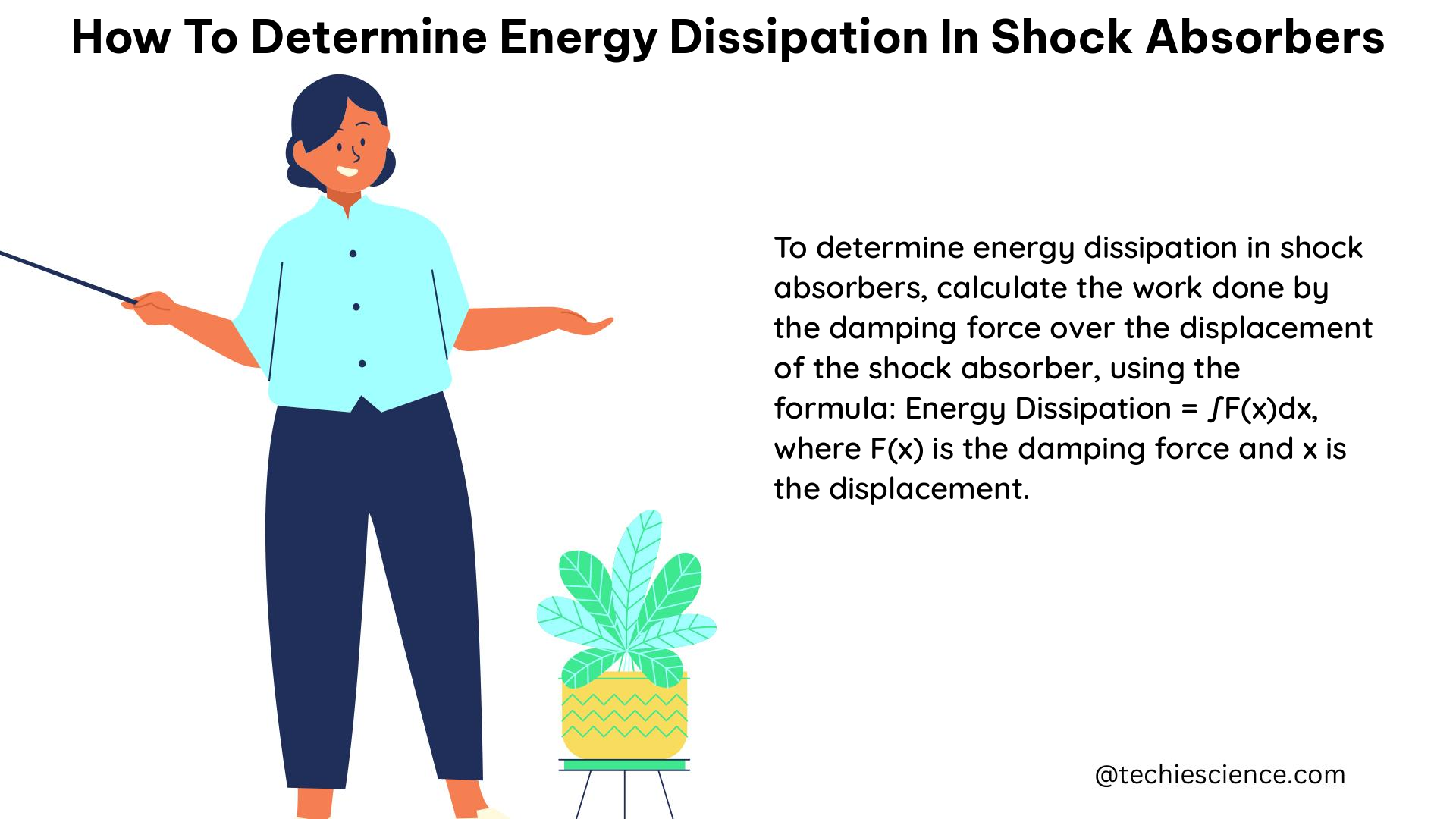Determining the energy dissipation in shock absorbers is a crucial aspect of designing and selecting the appropriate shock absorber for a given application. This comprehensive guide will provide you with a deep understanding of the key parameters, theoretical explanations, and step-by-step calculations to accurately determine the energy dissipation in shock absorbers.
Key Parameters for Energy Dissipation Calculation
To determine the energy dissipation in shock absorbers, we need to consider the following key parameters:
1. Kinetic Energy
- W1: Kinetic energy per cycle, calculated as
W1 = 0.5 * m * v^2(Nm). - W2: Propelling force energy per cycle, calculated as
W2 = F * s(Nm). - W3: Total energy per cycle, calculated as
W3 = W1 + W2(Nm). - W4: Total energy per hour, calculated as
W4 = W3 * c(Nm/hr).
2. Mass and Velocity
- m: Mass to be decelerated (kg).
- v: Impact velocity at the shock absorber (m/s).
3. Propelling Force and Cycles
- F: Propelling force (N).
- c: Cycles per hour (1/hr).
4. Shock Absorber Stroke and Deceleration
- s: Shock absorber stroke (m).
- a: Deceleration (m/s^2), calculated as
a = 0.75 * v.
5. Reaction Force and Time
- Q: Reaction force (N), calculated as
Q = 1.5 * W3 / t. - t: Deceleration time (s), calculated as
t = 2.6 * s / v.
Theoretical Explanation

The energy dissipation in shock absorbers is primarily determined by the kinetic energy of the mass being decelerated and the propelling force applied. The total energy per cycle is the sum of the kinetic energy and the propelling force energy. This total energy is then multiplied by the number of cycles per hour to obtain the total energy per hour.
The shock absorber stroke and deceleration are also critical in determining the reaction force and time. The deceleration is calculated as 0.75 times the impact velocity, which is a commonly used approximation. The reaction force is then calculated based on the total energy per cycle and the deceleration time.
Example Calculations
Let’s consider two examples to illustrate the energy dissipation calculations.
Example 1: Mass without Propelling Force
Given:
– Mass to be decelerated, m = 100 kg
– Impact velocity, v = 2 m/s
– Cycles per hour, c = 500 1/hr
Calculations:
1. Kinetic energy per cycle, W1: W1 = 0.5 * m * v^2 = 0.5 * 100 * (2)^2 = 113 Nm
2. Total energy per cycle, W3: W3 = W1 = 113 Nm
3. Total energy per hour, W4: W4 = W3 * c = 113 Nm * 500 = 56,500 Nm/hr
4. Effective mass, me: me = m = 100 kg
Example 2: Mass with Propelling Force
Given:
– Mass to be decelerated, m
– Impact velocity, v
– Propelling force, F
– Shock absorber stroke, s
– Cycles per hour, c
Calculations:
1. Kinetic energy per cycle, W1: W1 = 0.5 * m * v^2
2. Propelling force energy per cycle, W2: W2 = F * s
3. Total energy per cycle, W3: W3 = W1 + W2
4. Total energy per hour, W4: W4 = W3 * c
5. Effective mass, me: me = m
Advanced Considerations
-
Deceleration Curve: The deceleration curve of the shock absorber can significantly impact the energy dissipation. Shock absorbers with different deceleration characteristics, such as linear, progressive, or digressive, will have varying energy dissipation profiles.
-
Damping Coefficient: The damping coefficient of the shock absorber is another important factor that affects the energy dissipation. The higher the damping coefficient, the more energy the shock absorber can dissipate.
-
Shock Absorber Design: The design of the shock absorber, including the materials, construction, and internal mechanisms, can influence the energy dissipation characteristics. Advanced shock absorber designs, such as hydraulic, pneumatic, or hybrid systems, may have different energy dissipation properties.
-
Environmental Conditions: The operating environment, such as temperature, humidity, and pressure, can affect the performance and energy dissipation of shock absorbers. Proper selection and design of shock absorbers should consider the expected environmental conditions.
-
Fatigue and Wear: Over time, shock absorbers may experience fatigue and wear, which can alter their energy dissipation characteristics. Regular maintenance and inspection are crucial to ensure the shock absorber’s performance remains within the design specifications.
Conclusion
Determining the energy dissipation in shock absorbers is a critical step in the design and selection process. By understanding the key parameters, theoretical explanations, and step-by-step calculations, you can accurately assess the energy dissipation characteristics of shock absorbers and ensure their optimal performance in your applications.
Reference:
- Calculation basis industrial shock absorbers – ACE Controls Inc.
- Work Energy Equation Help (what size shock absorber to use)
- The Shock Absorber Handbook – Wanderlodge Gurus

The lambdageeks.com Core SME Team is a group of experienced subject matter experts from diverse scientific and technical fields including Physics, Chemistry, Technology,Electronics & Electrical Engineering, Automotive, Mechanical Engineering. Our team collaborates to create high-quality, well-researched articles on a wide range of science and technology topics for the lambdageeks.com website.
All Our Senior SME are having more than 7 Years of experience in the respective fields . They are either Working Industry Professionals or assocaited With different Universities. Refer Our Authors Page to get to know About our Core SMEs.